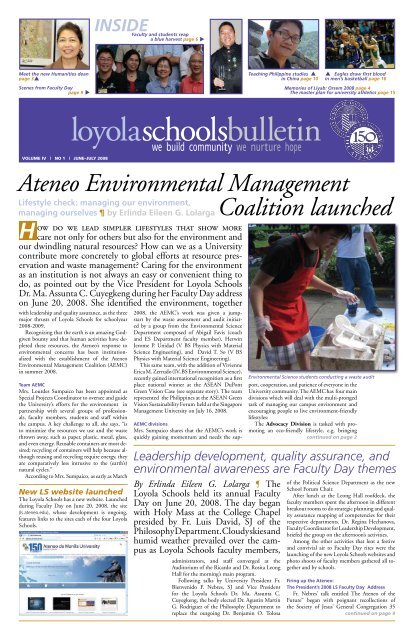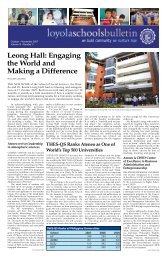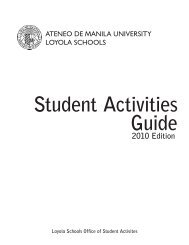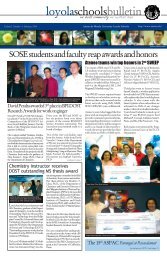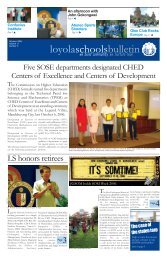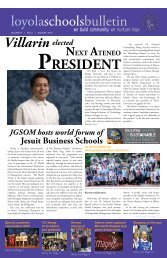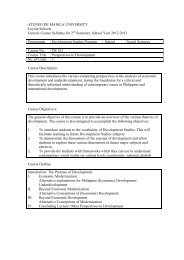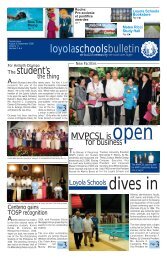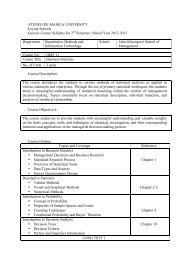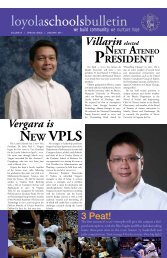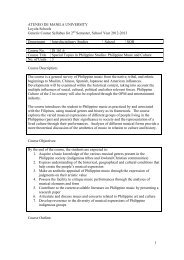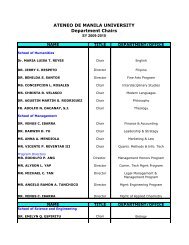orsem 2008 - Ateneo de Manila University
orsem 2008 - Ateneo de Manila University
orsem 2008 - Ateneo de Manila University
Create successful ePaper yourself
Turn your PDF publications into a flip-book with our unique Google optimized e-Paper software.
2AEMC launchedcontinued from page 1your own food containers (“baunan”), drasticallyreducing the use of plastic and paper packaging inevents, minimizing the use of tarpaulin bannersbecause of PVC health risks, using air-conditionersless, and conserving water and electricity. Thedivision is composed of the Sanggunian ng mgaMag-aaral ng mga Paaralang Loyola ng <strong>Ateneo</strong><strong>de</strong> <strong>Manila</strong>, the Council of Organizations of the<strong>Ateneo</strong> and the Office of Stu<strong>de</strong>nt Activities. Thisgroup is expected to translate for the communitythe findings of the coalition’s other divisions andclarify what steps will have a real impact in protectingthe environment. The spirit of Christianstewardship and practicality is emphasized as themotivations for living a life sensitive to the environment.The stu<strong>de</strong>nt groups are now craftinggui<strong>de</strong>lines that will foster environment friendlyorganizations.The Waste Audit Division is assigned to provi<strong>de</strong>information on the waste generation of theLoyola Schools as a base for policy formationand in the <strong>de</strong>velopment and implementationof more ecologically-sound waste managementgui<strong>de</strong>lines. Loyola Schools entities involved inthis division inclu<strong>de</strong> the Environmental Scienceteam (Ms. Favis and stu<strong>de</strong>nts Jerome Unidad,David Tan So, and Vivienne Zerrudo), withThe recently formed <strong>Ateneo</strong> EnvironmentalManagement Coalition (AEMC) won first placein the DuPont Green Vision Case Challenge ina competition held at the DuPont head office inloyolaschoolsbulletinOffice of the Vice Presi<strong>de</strong>nt for the Loyola SchoolsEditor Joanna Ruiz Layout Exie Abola Writers Jonathan O.Chua, Gary C. Devilles, Anjeline <strong>de</strong> Dios, Erlinda Eileen G. Lolarga,Jason Inocencio, Rick Olivares, Camille T. Onglao, Anna Rojas,Joanna Ruiz, Alma Sy, Cholo Torres, Rafael Saldaña, Scott AllisonG. Si Photos courtesy of <strong>Ateneo</strong> Environmental ManagementCoalition, <strong>Ateneo</strong> <strong>de</strong> <strong>Manila</strong> <strong>University</strong> Press, Council of Activities,CK Chua, Toby Dayrit, Jimmy Domingo, Nono Felipe, Rani Jalandoni,Marx Lopez, <strong>Manila</strong> Observatory, Jolly Morata, Ambeth Ocampo,Anna Rojas, Rafael Saldaña, School of Science and Engineering,Alma Sy, Tanghalang <strong>Ateneo</strong> With the assistance of PaulaAngeles, <strong>Ateneo</strong> Sports Shooters, Ricky Abad, Clark Alejandrino,Marivi Cabason, Connie Camacho, Karen Berthelsen Car<strong>de</strong>nas,Leland <strong>de</strong> la Cruz, Jet Damazo, Anjeline <strong>de</strong> Dios, Anna Galvez,Koi Mejia, Chita Rosales, James Simpas, Carla Siojo, Tanghalang<strong>Ateneo</strong>, Milet Ten<strong>de</strong>ro, Racky Tizon, Cholo Torres, Art Valencia,Nette Zabala, Ma. Carmi ZateLoyola Schools Bulletin © <strong>2008</strong> is published bimonthly by theOffice of Research and Publications, 2F Gonzaga Hall, LoyolaSchools, <strong>Ateneo</strong> <strong>de</strong> <strong>Manila</strong> <strong>University</strong>, Katipunan Avenue, LoyolaHeights, Quezon CityEmail Mailing address P.O. Box 154,<strong>Manila</strong> 0917, Philippines Telephone (632) 4266001 ext 5002 Fax(632) 4266096 Web Contributions If you would like to contribute stories andphotographs to, write for, or have any story i<strong>de</strong>as for the LoyolaSchools Bulletin, please get in touch with Joanna Ruiz at or (632)4266001 ext 5002.the Environmental Science Society, School ofScience and Engineering (SOSE) faculty, andthe Office of Administrative Services (OAS).The profile generated by the group will serveas platform for the changes the Coalition maypropose to improve the <strong>Ateneo</strong> community’slifestyle.The Research and Analysis Division, led bythe Sanggunian, has visited sites with systems forsegregation, composting, and material recovery,while Dr. Tess Perez of the Environmental ScienceDepartment and her stu<strong>de</strong>nts are looking at theLoyola Schools ecological footprint (rate of electricalconsumption, control of air-conditioneruse, conversion of fluorescent bulbs to energysavinglight fixtures). Also beinglooked into is the effect ofvehicle emissions on the environment.The Logistics andImplementation Division, ledby the OAS, is looking into cafeteriawaste (at AMPC, Blue andGold, Manang’s, JSEC) and theminimization of plastic and paperpackaging. It is also studyinghow existing buildings canbe ma<strong>de</strong> more environmentfriendlythrough measures suchas shifting to compact fluorescentlights (CFL), electronicballasts (if CFLs are not advisable),and reclaiming classroomspace that does not need airconditioning.L O Y O L A S C H O O L S B U L L E T I NMaking it happen: A green <strong>Ateneo</strong>The AEMC is looking forward to <strong>de</strong>veloping aMaterials Recovery Facility (MRF) that addressesthe need to re-cycle highly linear consumption byredirecting recoverable wastes from the garbagegenerated on campus. The MRF will augment thepresent segregation-at-source system. Segregatedtrash will further be sorted into finer categories(glass, aluminum cans, various classes of plastics,etc.). In doing this, the by-products of the community’sconsumption are recovered and redirectedback into the system as recyclables, for use asresources. This will eventually help minimize theamount of waste to be disposed of. In line withthis, the group has visited nearby communitiessuch as Barangay Bagumbahay and Barangay HolySpirit which have existing Materials Recovery andComposting Facilities (MRCF) to gather moreinformation on the motivation, methodology ofsegregation and recovery and returns of the runningsystems.Makati on July 2, <strong>2008</strong>.The AEMC team, composed of David T. So(BS Ps ’08, V BS MSE), Herwin Jerome P. Unidad(BS Ps ’08, V BS MSE), and Vivienne Erica M.Zerrudo (IV BS ES) and coached by AbigailFavis (Instructor, ES Department), won the conteston the basis of their project entitled “Wasteto-ResourceConversion at the Loyola Schools,<strong>Ateneo</strong> <strong>de</strong> <strong>Manila</strong> <strong>University</strong>.”The Waste-to-Resource Conversion Projectaims to recyclize the linear consumption patternsof the Loyola Schools. Recognizing that wastecan be a resource means minimizingour environmental impactas well as reaping economicbenefits.The two-fold solution proposedin the project is the constructionof a materials recoveryfacility (MRF) and a compostingfacility (CF). The MRF willbe the repository of recyclablessuch as plastics (PET bottles,polystyrene food containers andpolyethylene bags) before theseare sold to recyclers. The CFwill take care of the bio<strong>de</strong>gradablewaste such as kitchen scrapsand yard waste, which comprisemore than 50% of the totalwaste generated in the LS.AEMC members visit a Quezon City barangay to learn more aboutmaterials recovery and compostingRecognizing that the earth is an amazing God-given bounty and thathuman activities have <strong>de</strong>pleted these resources, the <strong>Ateneo</strong>’s responseto environmental concerns has been institutionalized with the establishmentof the AEMC. A key challenge to all, Sumpaico says, “is to minimizethe resources we use and the waste thrown away.”Mrs. Sumpaico also cites the service learningactivities of Management stu<strong>de</strong>nts that have to dowith segregation. She sees them putting theoriesto practice by adopting projects friendly to theenvironment.Another upcoming project is the creation oflandscaped pocket gar<strong>de</strong>ns (highlighted by an appropriateicon) in three strategic areas that willbe conducive to prayer and quiet reflection. Thefirst such gar<strong>de</strong>n is set to be located at the backof the Immaculate Conception Chapel. There isalso a plan to convert the walkway connecting theEDSA walkway to Masterson Road besi<strong>de</strong> theChapel into a path with blooming flowers dubbedthe “Marian Walk.” This will be offered to Sci 10classes as part of their contribution to the greeningof the campus.The AEMC is a school-wi<strong>de</strong> effort. It is hopedthat each individual member of the community willbegin to think green and live in harmony with theenvironment. The success of the three R’s—reduce,reuse, and recycle—lies with each of us! LSBAEMC team wins first place in DuPont Green Vision Case ChallengeIn addition to winning US$ 1,500 as seedmoney for the project, Mr. So, Mr. Unidad andMs. Zerrudo represented the <strong>Ateneo</strong> and thePhilippines at the Sustainability Forum held atthe Singapore Management <strong>University</strong> on July16, <strong>2008</strong>.The AEMC is a multi-sectoral effort of stu<strong>de</strong>nts,faculty, and administrators. The AEMC isbeing supported by the LS administration throughLS Special Projects Coordinator Mrs. Lour<strong>de</strong>s C.Sumpaico. It un<strong>de</strong>rtakes environmental projectsusing scientific tools and analysis.The winning AEMC team: Abigail Favis, David T. So,Herwin Jerome P. Unidad, and Vivienne Erica M. Zerrudo
V O L U M E I V N O 1 J U N E – J U L Y 2 0 0 83The School of Humanities welcomesa new <strong>de</strong>anBy Gary C. DevillesRani JalandoniDr. Ma. Luz C. Vilches now heads the School ofHumanities. After a well-<strong>de</strong>served sabbatical leavelast year during which Dr. Benilda Santos servedas SOH Dean, Dr. Vilches, known to all as Marlu,is ready to get to work, with plans of continuingthe Humanities tradition and of invigorating the<strong>Ateneo</strong> community with awareness of our culturalpast, commitment to scholarship, and passion forteaching.The tasks may be formidable but for Marlu,<strong>de</strong>anship is not merely about getting things done.“Lea<strong>de</strong>rship is really about working and <strong>de</strong>alingwith people. It’s more about people managementthan program management,” says Marlu, whois accustomed to <strong>de</strong>aling with different kinds ofpeople, from fellow members in the diverse standingand adhoc committees of the school, colleaguesfrom the British Council, CHED, and theWorld Health Organization, tofellow faculty members, beingthe former chair of the EnglishDepartment and the FacultySchool Forum.Although, she is not newto the <strong>de</strong>mands of lea<strong>de</strong>rship,Marlu believes that nobody isreally prepared for <strong>de</strong>anship.“One can rely on similar experiencesin the past, but of course,in the end one treats the workof a <strong>de</strong>an as an opportunity togrow and learn,” she reflects.One of the first activities initiatedby Marlu was to get SOHfaculty members together fora seminar-workshop which allowedthem to get to know eachother better and to set realitisticexpectations and goals for theschool over the next two years.For her, it is important to havea sense of collective in work andactivity. She believes that by tappingkey people in the school andinspiring them to work as a team, the school takeson form and becomes visible and recognizable.“It is important for every faculty memberand stu<strong>de</strong>nt to have a feel of what the School ofHumanities is,” she says. She is banking on everyone’sgood intentions for the school, and believesand that it is just a question of channeling efforts,recognizing successes, and seeing mistakes as opportunitiesfor improvement. Committees havebeen drafted with the aim of improving conditionsfor the faculty, staff, and stu<strong>de</strong>nts.One of the committee’s mandates is to gatherdata so that any policies, principles, and strategiesformulated will have a solid basis. In response tothe problem of the SOH’s dwindling stu<strong>de</strong>nt population,for instance, Marlu has commissioned asurvey of SOH alumni. The data culled from thesurvey will be presented to a faculty forum in or-<strong>de</strong>r to <strong>de</strong>termine how the SOH’s courses and programscan be ma<strong>de</strong> more relevant, and thereforemore attractive, to stu<strong>de</strong>nts.To provi<strong>de</strong> a venue for consultation and i<strong>de</strong>asharing,she plans to hold regular faculty forums.In addition, the <strong>de</strong>an is already working on anapprenticeship program for SOH stu<strong>de</strong>nts. Thisso-called “attachment program” is patterned afterattachment programs in British schools andwill help stu<strong>de</strong>nts situate their humanities backgroundsin a real-world context.Barely three months into her <strong>de</strong>anship, Marluis predictably kept busy with the school’s manyconcerns. At the end of the day, however, she acknowledgesthat one can only do so much. Toput what would seem a daunting workload intoproper perspective, she keeps in mind that noteverything is in our hands, that one must learnto trust that God sees and acts upon all things inHis own time. Whenever there is an opportunityto pray at any time of the day, Marlu retreats intoThe tasks may be formidablebut for Marlu, <strong>de</strong>anship is notmerely about getting thingsdone. “Lea<strong>de</strong>rship is reallyabout working and <strong>de</strong>alingwith people. It’s more aboutpeople management thanprogram management.”silence and centering. At times she is surprisedthat things are revealed in a better light throughconstant communion with God. Marlu, both inher constant dialogue with colleagues and in herintrospection, senses that the year presents greatchallenges and opportunities for all.First S.C. Johnson-<strong>Ateneo</strong> Environmental Lea<strong>de</strong>rship Forum heldThe S.C. Johnson-<strong>Ateneo</strong> EnvironmentalLea<strong>de</strong>rship Forum held its inaugural lecture onJuly 3, <strong>2008</strong> before a full house at the Auditoriumof the Ricardo and Dr. Rosita Leong Hall. Thisfirst lecture, entitled: “Perfect Storms: Whatshould the Philippines do about climate change?”featured three of the country’s climate change specialists,Fr. Jose Villarin, SJ, Dr. Antonio La Viña,and Ms. Antonia Yulo–Loyzaga.The Forum was atten<strong>de</strong>d by a number of keylea<strong>de</strong>rs in government, aca<strong>de</strong>me, and civil society,including Secretary Angelo T. Reyes of theDepartment of Energy, Un<strong>de</strong>rsecretary DemetrioIgnacio of the Department of Environment andNatural Resources, Mr. Edgar Chua, presi<strong>de</strong>nt ofPilipinas Shell, Ms. Anabelle Plantilla, executivedirector of Haribon Foundation, plus officialsfrom the diplomatic corps and local governmentunits. Stu<strong>de</strong>nts and faculty members from over 20high schools also atten<strong>de</strong>d.During their one-and-a-half lecture, the threespeakers <strong>de</strong>scribed climate change as the “perfectstorm,” which is the result of the convergence ofhumanity’s improvi<strong>de</strong>nt past, its difficult present,and the uncertain future. The issues are notmerely scientific; climate change spans political,social, and economic dimensions, crosses nationalboundaries, and promises to impact future generationsin a crisis of global proportions.The lecture explored the spectrum of climatechange issues—from scientific to political dilemmas,from global to local impacts, and from internationalto Philippine responses—and advocatedan integrated adaptation-mitigation frameworkthat will address the impacts on the poor sectorsof society.The Forum was established through an endowmentfrom S.C. Johnson to commemorate its 50 thyear in the Philippines. This annual Forum aimsto highlight new and innovative i<strong>de</strong>as in the areasof environment and sustainable <strong>de</strong>velopment.It is hoped that the Forum will contribute to theevolution of new i<strong>de</strong>as and paradigms in environmentand sustainable <strong>de</strong>velopment.Fr. Villarin holds BS Physics <strong>de</strong>gree from the<strong>Ateneo</strong> <strong>de</strong> <strong>Manila</strong> and a PhD in AtmosphericPhysics from Georgia Institute of Technology. Hewas a member of the Intergovernmental Panel onClimate Change, which was a co-awar<strong>de</strong>e of the2007 Nobel Peace Prize. He is currently Presi<strong>de</strong>ntof Xavier <strong>University</strong>, Cagayan <strong>de</strong> Oro.Dr. La Viña finished AB Philosophy at the<strong>Ateneo</strong> <strong>de</strong> <strong>Manila</strong>, Bachelor of Laws from UPDiliman, and a PhD in Environmental Lawfrom Yale <strong>University</strong>. From 1996 to 1998, heserved as Un<strong>de</strong>rsecretary of the Department ofEnvironment and Natural Resources and participatedin the negotiations leading to the KyotoProtocol. He is currently the Dean of the <strong>Ateneo</strong>School of Government.Ms. Loyzaga holds a AB Political Science <strong>de</strong>greefrom the <strong>Ateneo</strong> <strong>de</strong> <strong>Manila</strong> and a Master inGovernment from Georgetown <strong>University</strong>. Sheis currently the Executive Director of the <strong>Manila</strong>Observatory, and manages various projects relatedto climate change and disaster management.Fr. Jett Villarin SJ speaks at the S.C. Johnson-<strong>Ateneo</strong> EnvironmentalLea<strong>de</strong>rship Forum.The event was organized by the EnvironmentalScience Department and the School of Scienceand Engineering’s Office of the Dean.RANI JALANDONI
4By Joanna Ruiz An interview with Council ofOrganizations of the <strong>Ateneo</strong> (COA) Presi<strong>de</strong>ntOscar “Koi” Mejia, III (V BSCHEM-MSE) isa master class in organization and efficiency.Prepared questions fly out the window as we aregui<strong>de</strong>d through a presentation on COA’s thrustsand plans for the schoolyear. Answers are provi<strong>de</strong>dbefore the questions are even asked. Marvellingat how “together” Koi is without sacrificing thatall-important human touch, we reflect that Koi’sprofessionalism must be a reflection of the grouphe heads.Meet the COAThe COA is composed of 47 accredited LoyolaSchools stu<strong>de</strong>nt organizations and is divi<strong>de</strong>d intonine clusters: Business, Faith Formation, Healthand Environment, Intercultural Relations, Issueand Policy Analysis, Media and the Creative Arts,COA Vision The Council envisions itself as a community of <strong>Ateneo</strong>stu<strong>de</strong>nt organizatons united in <strong>de</strong>veloping Ateneans to become ac tive,competent, and holistically formed lea<strong>de</strong>rs who initiate positive changeswithin the <strong>Ateneo</strong> community and in the greater society through theIgnatian tradition of service and excellence. COA Mission As theCouncil of Organizations of the <strong>Ateneo</strong>, we aim to <strong>de</strong>velop qualityorganizations thereby providing Ateneans venues for spiritual growth,professional competence, social involvement, health, environmentaland political awareness, cultural rootedness, and artistic expressionby leading organizations to be united, effect ive, empowered, andsystematic through proper guidance, dialogue, and support.L O Y O L A S C H O O L S B U L L E T I NTHE COUNCIL OF ORGANIZATIONS OF THE ATENEOOrganized, aligned, effectivePerforming Arts, Science and Technology, andthe Sector-Based Cluster. Between the counciland the different member organizations there is afine balance between in<strong>de</strong>pen<strong>de</strong>nce and collaboration,with organizations going about their ownactivities while staying atuned and aligned tothe COA’s objectives. Constantly keeping intouch with each organization, COA also coordinatesclosely with the Office of Stu<strong>de</strong>ntActivities (OSA).Prioritizing resultsFollowing a process of reflection un<strong>de</strong>rtaken beforethe start of the schoolyear, the COA has i<strong>de</strong>ntifiedthree key result areas, namely: I<strong>de</strong>ntity articulationand actualization; membership engagement;and collaboration and consolidation.The process of i<strong>de</strong>ntity articulation and actualizationencourages member organizations toalign themselves with the COA mission and vision,making nee<strong>de</strong>d adjustments to their ownmissions and visions along the way. This processof alignment will naturally go down to the levelof the organizations’ projects. COA plans toaccomplish this valuable foundational processthrough consultations with each organizationand with OSA.The more straightforward goal of membershipengagement has three si<strong>de</strong>s to it: increasedmembership involvement, increased membershipretention, and increased membership involvement.To this end, COA will work with the OSAand each organization to carefully package the organizationsand share best practices to attract andretain members, and to encourage members to bemore active in their organizations.The goal of collaboration and consolidationis a natural one for COA. The group aims to establishinternal and external ties, and strengthenexisting ones, to be able to <strong>de</strong>velop its core competencies.Collaboration between organizationsis encouraged so that each org benefitsfrom the strengths of other groups.Outsi<strong>de</strong> interestsBesi<strong>de</strong>s goals which focus on the relationshipsbetween COA and organizations, organizationsand their members, and organizations with otherorganizations, reaching outsi<strong>de</strong> the <strong>Ateneo</strong> is alsoa priority.COA is involved with the Ahon Foundation, acorporate social responsibility initiative of PhilwayMarketing which gathers books for libraries inpublic schools. A book drive is in the works, witha certain “quota” of books to be collected by eachorganization. Networking with other stu<strong>de</strong>nt organizationsfrom other schools in Metro <strong>Manila</strong>has also been initiated via the youth organizationnetworking website OrgForward.It is no doubt that the COA has a big jobahead of it this year, what with the goals it hasset for itself and its member orgs. But if Koi’senthusiasm and can-do attitu<strong>de</strong> is any indication,then we needn’t worry that they’ll pull itoff in style.Liyab : OrSem <strong>2008</strong> Live the passion. Share the dream.We have 2,158 freshmen this schoolyear. Freshies were treated to a grueling but rewarding glimpse into <strong>Ateneo</strong> life during Liyab:OrSem <strong>2008</strong> from June 5 to 7, <strong>2008</strong>. Now that school is truly un<strong>de</strong>rway, that glimpse has turned into an everyday reality. Aca<strong>de</strong>mics,orgs, sports, friends, drama, doldrums, hitting the books, hanging out, giving back. Ang sarap maging Atenista!photos byRani Jalandoni
V O L U M E I V N O 1 J U N E – J U L Y 2 0 0 85traditionsMASS OF THE HOLY SPIRITCELEBRATED BY FR. JOSE CECILIO J. MAGADIA, SJPROVINCIAL OF THE PHILIPPINE PROVINCEOF THE SOCIETY OF JESUS | JUNE 12, <strong>2008</strong>PHOTOS BY RANI JALANDONITanghalang <strong>Ateneo</strong> celebrates 30 th repertory seasonTanghalang <strong>Ateneo</strong> marks its 30 th season by stagingclassical works infused with a contemporary,pan-Asian sensibility—the kind of productionthat has distinguished the company over the years.With “Echoes” as a season theme, the productionslisten to the voices of earlier masters and allowthem to resonate to young audiences today.Echoes of old <strong>Manila</strong>, filtered though NickJoaquin’s May Day Eve, kicked off the season thissummer. Aimed at a young audience, the play wasless about the tragedy of time than a cautionarytale of youthful recklessness. Stu<strong>de</strong>nt and professionalstage actors gave performances in Englishand Filipino, using the one-act play adaptation byAlberto S. Florentino, and translated into Filipinoby Jerry Respeto as Salamin . . . Salamin . . . (IsangGabi ng Mayo).In July, two classic plays by absurdist playwrightEugene Ionesco—The Bald Soprano andThe Lesson—were meshed into a series of comicvignettes echoing the theme of distorted communication.Taking its cue from the language games that pepper the plays, this production,simply titled “?”, questioned the reliance on rationality and power to establishmeaningful social relations.In August and September, Tanghalang <strong>Ateneo</strong> revisits William Shakespeare, acompany favorite, in a gut-wrenching version of Othello. Stu<strong>de</strong>nt talents work withprofessional stage actors to dramatize the havoc wreaked by insularity and prejudice.By dwelling on Iago’s aversion towards the foreigner Othello and on the consequencesof that antipathy, the play echoes the waves of ethnic and racial intolerancethat still plague many parts of the world today. The play is to be staged in aminimalist style and in bilingual format with Othello speaking in a tongue differentfrom his hosts.A relatively long hiatus prepares Tanghalang <strong>Ateneo</strong> for its February finale: a <strong>de</strong>constructionof Sophocles’ Oedipus Rex now titled Oedipus Rocks. The anger of rockmusic, especially written for the production, coupled with images drawn from theTanghalang <strong>Ateneo</strong> 30th Season Company with mo<strong>de</strong>rator Dr. Ricardo Abad (seated, center)theater of cruelty come to symbolize the wrath of a community against a proud lea<strong>de</strong>rwho transgresses the ethics of political life and causes a virulent plague. Oedipus maybe an acci<strong>de</strong>ntal victim of fate, but his choice to suffer for past sins stands out as anoble gesture to restore the integrity of the state. This is to be staged in Filipino usinga translation by Rolando S. Tinio.In each play, the consequences of indifference, hate and violence herald a new beginning.As in the Ionesco twin bill, the new is not always idiotic—it can be a replicationof old ways as in May Day Eve, a painful reconstruction as in Othello, or aslow process of moral recovery as in Oedipus Rocks. But in each drama, the ability ofthe theater to have us witness the struggles of others, and to learn from these privatebattles so that we may come out wiser and stronger, remains wholly intact.Tanghalang <strong>Ateneo</strong> invites the public to listen to these echoes of the past and toshape them in their own personal ways. For performance and booking <strong>de</strong>tails, contactIa Solis at 0916-5415165.
6L O Y O L A S C H O O L S B U L L E T I NThe Rizal Library, already named OutstandingLibrary of the Year by the Philippine Associationof Aca<strong>de</strong>mic and Research Librarians, has hadad<strong>de</strong>d another layer ad<strong>de</strong>d to its already toweringpile of honors.Lour<strong>de</strong>s T. David, director of the library, wasnamed one of the forty outstanding professionalsof the year by the Professional RegulationCommission (PRC). She received a glass trophy atthe awarding ceremony held at the <strong>Manila</strong> Hotellast 20 June <strong>2008</strong>.Mrs. David was recognized “for her sterlingaccomplishments as an internationally renownedprofessional, <strong>de</strong>monstrating exemplary <strong>de</strong>dication,competence and integrity . . .; for her invaluablecontributions in preparing the [UNESCO]training modules on library management, informationand communication technology, marketinginformation services, digital libraries and intellectualproperty rights; for her active involvementin various local and international professionalactivities which have put Filipino librariansat the forefront of international librarianship; forher able lea<strong>de</strong>rship of the Philippine LibrariansAssociation, Inc; and for selflessly sharing herknowledge and expertise. . . .”The recognition is timely. Since her appointmentas director of the Rizal Library in 2001, Mrs.David has been taking steps to ensure that the librarykeeps its prime position. Her main thrust remains“improving access to information.” Alreadythe library has digitized its holdings of majorPhilippine newspapers, making them convenientlysearchable, and its microfilming program is recognizedin Australia. “Our procedures,” she notes,“adhere to international standards.”Alongsi<strong>de</strong> efforts at improving library facilitiesand services is her aggressive staff <strong>de</strong>velopmentprogram. She regularly scouts for opportunitiesfor librarians and library staff to further or updatetheir training. One librarian has recently returnednotable achievementsRizal Library’s David named Outstanding Professional of the YearFor a three-pagestory he wrote fifteenyears ago,Danton Remoto,Associate Professorat the Departmentof English, recentlyreceived P20,000.“Wings of Desire”placed third atthe Nick JoaquinLiterary Contest of the Philippine Graphic. Theawarding ceremonies were held at the RiccoRenzo Gallery last 18 June <strong>2008</strong>.“That’s over P6,000 a page,” says Remoto.“That’s not a bad way to make good money.”A self-confessed Legal Management drop-outwho eventually shifted to Interdisciplinary Studies,Remoto has not forgotten his math; and apparentlyhe also knows how to make a good investment.“I’m earning from things I wrote in the past.”Remoto wrote the story while at Hawthorn<strong>de</strong>nCastle in Scotland in the early 1990s.When he offered his stories to local publishersthen, he recounts, some of them got rejected.“Then they were consi<strong>de</strong>red pornographic,” herecalls. “Now they are called ‘prize-winning’.”There is nothing at all remotely pornographic,however, about “Wings of Desire,” a poignantstory about a boy’s discovery of <strong>de</strong>ath. The ending,a dream sequence, is inspired, he says, byWim Wen<strong>de</strong>r’s film of the same title. Somethingof Joyce’s “The Sisters” hovers over the story. Itends very quietly: “Sometimes, when we call outa name, even the very wind crumbles.”Mrs. Lour<strong>de</strong>s David with fellow Outstanding Professionalsfrom a materials preservation course in NewZealand; another, from a language and librarianshiptraining in Japan (“The Japanese books canfinally be cataloged”). She has also encouraged librariansto attend or present papers at internationalconferences. Three, in fact, are at a conferenceof the American Library Association.What may one yet expect from the Rizal LibraryMr. Remoto has published a number of collectionsof poetry, but his recent prizes have beenfor his prose. In 2005 his story “The Heart ofSummer” (“one of those that got censored!”)won third prize at the annual literary contest ofthe Philippines Free Press. Two years earlier, hisessay “The House of Spirits” had won second.Why the shift? “Prose pays,” he says, “poetry . . .perishes.”When he is not being facetious, he tells me thathe has a new collection of poems awaiting publication.“Runes of Memory,” he calls it. He isalso preparing a collection of fiction (to be called“Wings of Desire and Other Stories”?) and anovel in progress tentatively entitled “A LightedMatchstick.” An excerpt from that novel (“a politicalsatire,” he <strong>de</strong>scribes it) is in Thought theHar<strong>de</strong>r, Heart the Keener, a festschrift for SoledadS. Reyes, launched earlier this year. (There thenovel is called “Pearl of the Orient.”)In hindsight, Remoto comes full circle withthis award. In the early 1990s, a story of his waspublished in the magazine. Nick Joaquin was thenthe literary editor. (When “Wings of Desire” waspublished, the late Adrian Cristobal, who also solicitedthe story from him, was the literary editor.)Joaquin sent him a note: “This is an excellentshort story. You will fly, boy.” A <strong>de</strong>ca<strong>de</strong> and a halflater, Remoto wins an award named after the lategreat National Artist. There is something in thatof the closure that the best short stories have andwhich English teachers love to point out.“I should frame that note,” he says, more to himselfthan to me. And on that note sounds the schoolbell, which sends Remoto off to another class.un<strong>de</strong>r her lea<strong>de</strong>rship? “A more organized outreachprogram in partnership with Pathways and AhonFoundation and Gawad Kalinga.” Mrs. David envisionsbuilding “an info center in a Gawad Kalingaarea in Nueva Ecija.”The award is most apropos, then, for an outstandingprofessional leading an outstanding institution.Jonathan O. ChuaRemoto makes a windfall from an old storyDanton RemotoWhen Remoto offered hisstories to local publishers then,he recounts, some of them gotrejected. “Then they wereconsi<strong>de</strong>red pornographic,” herecalls. “Now they are called‘prize-winning’.”“Wings of Desire” was published in thePhilippine Graphic, 26 November 2007, 40-42.Jonathan O. ChuaA Fulbright Award forDISCS’ RodrigoMa. Merce<strong>de</strong>s T. Rodrigo, Associate Professorwith the Department of Information Systems andComputer Science (DISCS), has received a grantun<strong>de</strong>r the Fullbright Scholar Program <strong>2008</strong>-2009Advanced Research and <strong>University</strong> LecturingAwards. The grant will allow Dr. Rodrigo to un<strong>de</strong>rtakea five-month research visit to CarnegieMellon <strong>University</strong> where she has established aresearch collaboration with Dr. Ryan Baker. Dr.Rodrigo will pursue research in the area of affectivecomputing, which seeks to un<strong>de</strong>rstand thecomputer learning environment which inclu<strong>de</strong>shuman-computer interaction, learning theory,and computer-ai<strong>de</strong>d instruction.Fabian Dayrit
V O L U M E I V N O 1 J U N E – J U L Y 2 0 0 87Ambeth OcampoCreating a bridge of un<strong>de</strong>rstandingAmbeth Ocampo receives the Ordre <strong>de</strong>s artes et <strong>de</strong>s lettres from the Republic of FranceAmbeth Ocampo, assistant professor at theDepartment of History, has something in commonwith Ella Fitzgerald, Kylie Minogue, andDiana Ross: the Ordre <strong>de</strong>s artes et <strong>de</strong>s lettres. Mr.Ocampo was given the rank officier last 26 July<strong>2008</strong> in a ceremony held at the Alliance Françaisein Makati. He received a medal—“an eight-point,green-enameled asterisk, in gilt” with the “letters Aand L on a white enameled background, surroun<strong>de</strong>dby a gol<strong>de</strong>n ring emblazoned with the phraseRépublique Française” on the obverse si<strong>de</strong>—fromthe French Ambassador to the Philippines.The Ordre <strong>de</strong>s Artes et <strong>de</strong>s Lettres is given by theFrench Minister of Culture and Communicationto “persons who have distinguished themselves inthe arts and literature or the propagation of thesefields in France and worldwi<strong>de</strong>.”What has Mr. Ocampo done in this regard? He iscited by the French Minister of Culture and Culturefor his work as writer, teacher, and cultural administrator.“I have been researching on our heroes inParis—Jose Rizal, Juan Luna, Felix ResurreccionHidalgo—thus using the past to create a bridge ofun<strong>de</strong>rstanding between our countries [France andthe Philippines]”—a fact which he emphasizes inhis acceptance speech. “They were in Paris in1899,the centenary of the French Revolution, and nodoubt the i<strong>de</strong>as of freedom, the i<strong>de</strong>als of liberty,equality and fraternity rubbed off on them and influencedpeople who never left home. . . . My work. . . illustrates how the past can find a connectionwith the present, or how our heroes in the past byvisiting France established bridges of friendship thatpre-dates the establishment of formal diplomatic relationsbetween the Philippines and France. . . .”The 60 th anniversary of the establishment ofsuch relations was the occasion for a symposiumheld at the <strong>Ateneo</strong> <strong>de</strong> <strong>Manila</strong> last year, which, aschairman of the National Commission for Cultureand the Arts, Mr. Ocampo supported. He was oneof the speakers, and he is now editing the collectionof papers presented at the symposium.Mr. Ocampo is no stranger to awards. Howdoes he regard this latest one? “I am honored ofcourse, and while I do not show it, I do take a conceited<strong>de</strong>light in these honors. It is always good toFr. Bienvenido F. Nebres, SJ, <strong>University</strong> Presi<strong>de</strong>nt,and Dr. Queena N. Lee-Chua, Full Professor atthe Mathematics Department, were recognizedas two of the 50 Men and Women of Scienceby the Department of Science and Technology(DOST). The recognition was ma<strong>de</strong> in honor ofthe DOST’s 50 th anniversary in June <strong>2008</strong>.According to DOST Secretary Estrella F. Balbastro,“our activities and festivities pay homage to the nation’soutstanding achievements and breakthroughsin science and technology over the last 50 years. Webelieve that the work of scientists, researchers andother stakehol<strong>de</strong>rs must be recognized and given theopportunity to flourish, as it is the precursor to newknowledge as well as improved products, and processesvital for national <strong>de</strong>velopment.”Excerpts from Fr. Nebres’ and Dr. Lee-Chua’scitations from the DOST:Fr. Bienvenido F. Nebres, SJ (EducationIcon): “Fr. Nebres has successfully reconciled thefields of science and religion with his work, especiallyin the <strong>de</strong>velopment of mathematics and sciencein the Philippines and in Southeast Asia.After finishing his MS and PhD in Mathematicsat Stanford <strong>University</strong> in California, he foun<strong>de</strong>dthe Mathematical Society of the Philippines. He isalso one of the founding officers of the SoutheastAsian Mathematics Society. He pioneered a consortiumof leading universities in <strong>Manila</strong> to <strong>de</strong>velopPhD programs in Mathematics, Physics, andTOPMOST French Ambassador Gerard Chesnel, Mrs. Chesnel,Ambeth Ocampo, Alliance Francaise director Olivier DintingerABOVE With Loyola Schools colleagues Eduardo Calasanz,Ma. Assunta Cuyegkeng, and Leovino Ma. Garciabe recognized for your work.”Other members of the university who have been inducted intothe Or<strong>de</strong>r are Fr. Bienvenido F. Nebres, Antonette Palma-Angeles,and Leovino Ma. Garcia (each as chevalier) and Evelyn C. Soriano(as comman<strong>de</strong>ur). Jonathan O. ChuaAteneans make finals of <strong>Manila</strong>Jaycees’ Best Business Plan tiltThree of the top five teams at the annual BestBusiness Plan competition organized by theJunior Chamber International (JCI) <strong>Manila</strong> arefrom the <strong>Ateneo</strong>. They are:Ecobuil<strong>de</strong>rs, Inc. is engaged in the productionof tiles ma<strong>de</strong> from coconut husks (3rd place).The team is composed of Mariel Luz T. <strong>de</strong> Castro,Andrea Loraine A. Go, Jurmane A. Lallana,Dorthee Elline T. Li, and Daphne F. Melegrito.Ecovation, Inc. innovatively combines asphalt,aggregates and non-bio<strong>de</strong>gradable junkplastic for use as construction materials for roads,highway,s and bridges (4th place). The team iscomposed of Reb Kerwin Ata<strong>de</strong>ro, Alyssa ReneeCruz, Margarita <strong>de</strong> Leon, Jacqueline Gorospe,Hyra Liwanag, and Charmaine Santos.Dee Medical Corp. produces two-in-one lowcostorganic gel-based post-operational woundremedy (5th place). The team is composed ofJan Jizelle Ang, Gregorio Camacho, Brian MarcoChayungco, Celine Melanie Dee, Jose RamonGelvezon, and Ana Margarita Oliveros.Together with teams from the <strong>University</strong> ofthe Philippines and Jose C. Feliciano College inPampanga, they will represent the Philippines atthe Best Business Plan Competition World Finalsorganized by the Junior Chamber Internationalor Jaycees. The world finals will be held at NewDelhi, India this November <strong>2008</strong>.The national finals, meanwhile, were held onJune 18, <strong>2008</strong> at the boardroom of the PhilippineStock Exchange (PSE). The judges for the nationalfinals were Philippine Star columnist WilsonLee Flores, GMA 7 top executive Rod Cornejo,Philippine Chamber of Commerce Vice Presi<strong>de</strong>ntand Anvil Business Club Honorary ChairmanGeorge Siy, Philippine Stock Exchange Governorand Anvil Regent David Chua, and PSE marketingeducation division head Leo Quinito.www.ateneo.eduNebres and Lee-Chua among 50 Men and Women of ScienceChemistry. This led to the <strong>de</strong>velopment of a criticalmass of scientists in these areas.Fr. Nebres chaired the Engineering and ScienceEducation Project of the DOST and directed ateam for the Department of Education on the <strong>de</strong>velopmentof education plans to strengthen elementaryand secondary education in the country’spoorest provinces.”Queena N. Lee-Chua (Outstanding ScienceCommunicator): “In this millennium, scienceliteracy is paramount to remain competitive in theglobal arena. All channels of creative and interestingscience communication need to be harnessedfor Filipinos to achieve technological un<strong>de</strong>rstandingand appreciation.”Lee-Chua, in her own words, best <strong>de</strong>scribesher passion to share and spread the value of un<strong>de</strong>rstandingscience both insi<strong>de</strong> and outsi<strong>de</strong> thelecture hall. Numerous books, articles, lectures,columns, and other communication tools in hername mirror a vastly creative and disciplined persona.She has written science and math books,a newspaper column, and teachers both subjectsto stu<strong>de</strong>nts, parents, media, and practically everybodyelse. But she remains consistent in her goalto make science and math learning “fun” through“simpler, more un<strong>de</strong>rstandable language.” Shebrings the “fun” to print, radio, TV, online, andinterpersonal audiences.Among her numerous awards are TheRani Jalandoninotable achievementsOutstanding Women in the Nation’s Service (2001),Outstanding Young Scientist (National Aca<strong>de</strong>myof Science and Technology, 2002), First MultipleIntelligence Award (Dr. Howard Gardner, MultipleIntelligence International School Foundation, Inc.,2005), Outstanding Teacher Award (MetrobankFoundation, 2003), National Book Award forScience (2003), Carlos Palanca Memorial Awards foLiterature (1st place, English Essay, 2001),Scienceand Technology Journalism Awards (PhilippinePress Institute-Philippine Geothermal Inc, 1992),and Best Science and Technology Columnist(DOST, special citation, 2005).The 50 Men and Women of Science exhibit,showing photographs of all the awar<strong>de</strong>es, may beviewed at the UP Theatre in Diliman throughSeptember <strong>2008</strong>.BELOW LEFTBienvenido F.Nebres, SJBELOWQueena N.Lee-ChuaQueena Lee-Chua
10L O Y O L A S C H O O L S B U L L E T I NClose encounters with life, education, and culture inThe author,leftmost, withfriends inBeijing.The following narrative was shared by Marco Antonio “Marx” V. Lopez,Assistant Professor at the Filipino Department, School of Humanities.Marx was sent on his second tour as an exchange professor to China’spremier university, Peking <strong>University</strong> in Beijing. He left for China inJanuary <strong>2008</strong> with his term in Peking <strong>University</strong> covering the periodFebruary to December <strong>2008</strong>. With support coming from the Office ofthe Vice-Presi<strong>de</strong>nt of the Loyola Schools (Peking <strong>University</strong> takes caresof his board and lodging on campus), his teaching stint for the year isbased at Philippine Studies Program of the Department of OrientalLanguages of Peking <strong>University</strong>. Here is his narrative of life in Beijingas an exchange professor.The Philippine Studies Programat Peking <strong>University</strong>I handle the Filipino Intermediate Language andPhilippine Literature classes, meeting them everyday. I have ten stu<strong>de</strong>nts (but at present just9 because one of them is an exchange stu<strong>de</strong>ntin <strong>Ateneo</strong> for a year). In the Philippine StudiesProgram, stu<strong>de</strong>nts study almost all aspects ofPhilippine culture—language, literature, history,economy, popular culture, among others. Mostof the teachers now are graduates of the programitself. The program invites a native speaker fromthe Philippines to handle the language and literatureclasses, usually in the first or second yearof the stu<strong>de</strong>nts. Because of an existing ExchangeProgram between Peking <strong>University</strong> and the<strong>Ateneo</strong> <strong>de</strong> <strong>Manila</strong>, <strong>Ateneo</strong> has been sending ateacher to teach in the program since the mid-1990s (Note: the exchange program between the<strong>Ateneo</strong> and Peking <strong>University</strong> was first establishedin 1991). In the past, among the professors sentby the <strong>Ateneo</strong> to participate in the program were:Mr. Roberto Ortañez, Dr. Florentino Hornedo,Mrs. Nenita Escasa, Ms. Janneth Candor andMr. Joseph Salazar. I was sent here in 1999 andwhen given the opportunity, I <strong>de</strong>ci<strong>de</strong>d to teachagain this year, <strong>2008</strong>.The Philippine Studies Program in Peking<strong>University</strong> must have started sometime in the1980’s (originally with professors from the<strong>University</strong> of the Philippines coming there toteach some courses). It is a program where theyallow 10 to 15 stu<strong>de</strong>nts to take Philippine Studiesas their major. It is not every year that they getstu<strong>de</strong>nts to major in it; it is open only every fouryears. A stu<strong>de</strong>nt taken in the program cannot shiftto other programs in the university; he or shegraduates as a Philippine Studies major. It is theonly program of its kind in China. Out of the 1.4billion Chinese, 10 to 15 stu<strong>de</strong>nts every four yearsmajor in Philippine Studies. Personally, I believeit is worth supporting. Many of the graduates ofthe program work in institutions that <strong>de</strong>al withthe Philippines. Two of my former stu<strong>de</strong>nts in1999 are now professors of the program and twoare working in the Philippine section of the ChinaRadio International. One of the two teachers—this is Shi Yang or “Ato”, his Filipino name—isstudying the oral literature of the Mangyans inMindoro, for which study he was given a grant tofinish his doctoral studies at Harvard next year.Wu Jie Wei, or “Jack” as his Filipino friends callhim, one of the early graduates of the program,is now the Vice Dean of the Oriental LanguagesDepartment (Note: Jack belonged to the firstbatch of stu<strong>de</strong>nts taught by the <strong>Ateneo</strong> professorswhen they first came in the mid-1990s).China then and now: changes observed1999 and <strong>2008</strong>There appear to be have been many changes heresince my first visit to Beijing in 1999. Chinanow <strong>de</strong>finitely seems more open to the world an<strong>de</strong>ven looks infinitely richer. The big change is apparenton and off campus. It is still a beautifulcampus: the old section with the man-ma<strong>de</strong> lakeis still there, surroun<strong>de</strong>d by the old buildings inthe traditional architecture, while in other parts ofthe campus you will find the new massive buildingsin minimalist style. In this latter section youmay think you are in an American campus. In1999 I would get paranoid because the stu<strong>de</strong>ntswould tell me not to be critical of the governmentbecause members of the party are all overthe campus. I don’t get the same feeling now. Mystu<strong>de</strong>nts today seem so much like our stu<strong>de</strong>nts in<strong>Ateneo</strong>—besotted with American songs, movies,soccer, computer games, baseball and basketball.Nevertheless, my Chinese stu<strong>de</strong>nts are still as diligentas before in their studies. They have studiedFilipino for only two years in an environmentwhere Filipino is hardly heard but they are probablyfar more proficient in it than many Ateneanswho have stayed all their lives in the Philippines.“Malling” is not yet in their system. Althoughone sees that China is becoming a consumerist culture,the stu<strong>de</strong>nts in general are as simple as beforein terms of fashion and lifestyle. However, thismay change soon. In 1999 there were small storesBeijingBY MARCO ANTONIO V. LOPEZaround the campus selling cheap products and piratedDVDs. These stores are now gone. Near thecampus is an empire of above- and un<strong>de</strong>rgroundmalls that can rival our malls in the Philippines.With Peking <strong>University</strong> hosting the table tennisevents of the Olympics, the campus—as well as thecity itself of course—is spruced up. There is stillonly one English channel—CCTV 9—run by thegovernment, but I often hear critical comments ofthe government, which seemed unheard of beforein 1999. I really believe the Olympics this year istheir <strong>de</strong>but to the global world. I think we will seeand hear a lot more of China from here on.Social life and leisure in BeijingI always think that a stint in China is comparableto a retreat. Life in the Philippines can benoisy—literally and figuratively—at times. Mylife on campus here can be the other extreme: aftermy classes in the morning, I go back to myOf the 1.4 billion Chinese, 10 to 15 stu<strong>de</strong>nts every four years major in PhilippineStudies. Many of the graduates of the program work in institutions that <strong>de</strong>al withthe Philippines. Two of my former stu<strong>de</strong>nts are now professors of the program, oneof whom is studying the oral literature of the Mangyans in Mindoro.room on the fifth floor which can be very silentsave for the usual hum of a city with heavy traffic.Traffic here, by the way, is infinitely heavier nowcompared 1999. There are more cars everywhere,displacing the iconic Beijing bicycle. It is moredangerous here to cross an avenue than in <strong>Manila</strong>because of many bicycles, including electric bicycles.We don’t have the latter in <strong>Manila</strong> but itis their counterpart of our motorcycles which isbanned here. Cars and pe<strong>de</strong>strians, it seems, don’tfollow traffic signs.For a non-Mandarin speaking person in Beijing,life can be restricted. It is difficult to have friends.I cannot even converse with the cleaning lady whoI see everyday. We manage to communicate withgestures and the occasional ni hao. People tendto avoid you if you speak in English. I rely mostlyon cultural co<strong>de</strong>s to be able to survive here. Ishould have studied Mandarin, but even for me,a language teacher who also studied the Romancelanguages, Chinese is very difficult, starting withthe sounds and not even consi<strong>de</strong>ring the tones.Orhan Pamuk, the Nobel Literature awar<strong>de</strong>e in2007, was here to give a lecture recently, but Imissed it because the posters announcing the activitywere in Chinese! Beijing is still not touristfriendly because of the language. But a colleagueof mine would say, we don’t need tourists!They have good and big bookstores in andnear the campus, but I still miss the bookstores in<strong>Manila</strong> with entire floors of Filipino and Englishbooks. Here they have four- or five-floor bookstoreswith mostly Chinese books save for a shelfor two of foreign books. I nee<strong>de</strong>d to bring a lotof books to read for leisure. Also because of myage—matanda na (getting ol<strong>de</strong>r)—I don’t go outat night anymore. In 1999, I would go out withthe Filipino stu<strong>de</strong>nts at the Beijing Languageand Culture <strong>University</strong> and try different restaurantsand bars. I got to meet many Filipinos whowere members of bands playing in different bars.Night life should be more exciting now, especiallywith the Olympics just around the corner, but Iwouldn’t really know. A Filipina I met at the airportrecently said that I should go out if I want tomeet many Filipinos. Apparently there are manyFilipinos now working in Beijing, and a lot ofthem are supposedly TNTs. Kung nasaan ang trabaho,may mga TNT (Where there is work, youwill find TNTs). I suppose life here is like that ofthe life of any OFW (overseas Filipino worker).continued on page 14
12L O Y O L A S C H O O L S B U L L E T I NServing to learn, learning to serveBy Cholo Torres This year, stu<strong>de</strong>nts from variousaca<strong>de</strong>mic disciplines will go outsi<strong>de</strong> the confinesof their classroom in or<strong>de</strong>r to serve the un<strong>de</strong>rprivilegedsectors of society. But they will alsodo it while learning insi<strong>de</strong> the classroom. Soundsimpossible? Not with service learning.Because of the <strong>University</strong>’s continued commitmenttowards forming men and women for otherswho will be at the forefront of nation-building,the Loyola Schools is promoting the conceptof service learning as an avenue for fosteringfaculty and stu<strong>de</strong>nt social involvement. It entailsstu<strong>de</strong>nts working with a social <strong>de</strong>velopment institution(government, non-government organizations,people’s organizations, cooperatives,community centers) through a project which isconsi<strong>de</strong>red a part of their aca<strong>de</strong>mic requirements,thus linking social involvement with aca<strong>de</strong>miclearning. Through this en<strong>de</strong>avor, both facultyand stu<strong>de</strong>nts can utilize their acquired skills andknowledge in their respective disciplines whileren<strong>de</strong>ring service to society, thus becoming professionalsfor others.Various faculty members of the Loyola Schools“Service-learning teaches stu<strong>de</strong>nts thatthey can use their professional skillsfor social <strong>de</strong>velopment. Hopefully thiswill carry on even after they graduate.Also, stu<strong>de</strong>nts sometimes have a hardtime framing encounters with NGOs orcommunities. Service-learning provi<strong>de</strong>sthe initial frame for them which makesthe encounters much less awkward.”— Leland <strong>de</strong> la Cruzhave volunteered to embark on this initiative, withthe Coordinator for Faculty Social InvolvementMr. Leland Joseph <strong>de</strong> la Cruz (also the Director ofthe Development Studies Program) facilitating theencounter between the faculty members and varioussocial <strong>de</strong>velopment institutions. Service learning,he says, “is an efficient way of getting stu<strong>de</strong>ntsand faculty involved in the task of social transformationbecause the time they use in being involvedis the same time they use for fulfilling their aca<strong>de</strong>micresponsibilities. It isn’t “extra”-curricular.”Several Loyola Schools aca<strong>de</strong>mic <strong>de</strong>partmentswill take part in this initiative throughout theService learning as a social involvementinitiative in the Loyola SchoolsSchool Year <strong>2008</strong>-2009, with projects alreadyrolling off this first semester. Stu<strong>de</strong>nts will visittheir respective partner institutions to conduct researchwork and other projects for them. Uponcompletion, the stu<strong>de</strong>nts will present and turnover the service learning outputs to the partnerinstitutions.To mention a few of the participating classes,Philippine Business and Economic Environment(L&S 10) stu<strong>de</strong>nts will come up with industry researchstudies for institutions such as Kabalikat ngBotika Binhi Inc. (KBBI) which established 800+village pharmacies selling generic medicines, Non-Timber Forest Products (NTFP) which marketslocally-ma<strong>de</strong> food and crafts ma<strong>de</strong> by indigenouspeoples, and Business Support OrganizationsNetwork Association (BSO Network) which servesas an umbrella organization of the country’s leadingmanufacturing and exporting industries. Onthe other hand, stu<strong>de</strong>nts enrolled in the SystemsAnalysis and Design (MIS 121) will come upwith systems and database <strong>de</strong>velopment projectsfor the National Confe<strong>de</strong>ration of Cooperativeswhich gives financial intermediation services toits member cooperatives all over the country. TheFine Arts Program has joined in as well, with itsIntroduction to Aesthetics (FA 101) classes conductingvarious performance and art workshopsfor the youth of Gawad Kalinga-<strong>Ateneo</strong> areas.It should be mentioned however, that this is notthe first time that the Loyola Schools has implementedservice learning. Through the years, servicelearning has been continuously implementedthrough the Praxis Program—a tie-up programbetween the Economics Department throughits Theory and Practice of Social Development(ECO 177) classes and the Theology Departmentthrough its A Theology of a Catholic Social Vision(TH 141) classes, with its activities mainly coordinatedand facilitated by the Office for SocialConcern and Involvement. Asi<strong>de</strong> from the PraxisProgram, service-learning type projects have beendone before for theses by various <strong>de</strong>partments.The current initiative seeks to transform evenmore courses into service-learning courses. Thisyear’s new service learning classes asi<strong>de</strong> from thosealready set up through the Praxis Program couldbe consi<strong>de</strong>red as a breakthrough in terms of pro-moting and implementing social involvement inan aca<strong>de</strong>mic set-up.What is crucial to this initiative is matchingup the needs of the social <strong>de</strong>velopment institutionswith the learning objectives of the stu<strong>de</strong>nts.Service learning is reciprocal in nature—it benefitsboth the social <strong>de</strong>velopment institutionand the stu<strong>de</strong>nts by combining a service experiencewith a learning experience, which, as a result,makes the concepts learned by the stu<strong>de</strong>ntsin class more relevant. Negotiations between the<strong>de</strong>velopment institutions and the participatingfaculty were conducted so that the needs of theinstitutions and the learning objectives and competenciesof the stu<strong>de</strong>nts could be matched. De laCruz remarks, “I think service-learning teachesstu<strong>de</strong>nts that they can use their professional skillsfor social <strong>de</strong>velopment. Hopefully this will carryon even after they graduate. Also, stu<strong>de</strong>nts sometimeshave a hard time framing encounters withNGOs or communities. Service-learning provi<strong>de</strong>sthe initial frame for them which makes the encountersmuch less awkward.”Asi<strong>de</strong> from the output, of equal importance isthe social formation process which the stu<strong>de</strong>ntswill un<strong>de</strong>rgo during their service learning experience.Thus, this linking of the ‘service provi<strong>de</strong>rs’and the ‘clients’ through service learning shouldnot be done without providing processing sessionsto remind stu<strong>de</strong>nts of the value of being professionalsfor others and being of service to the nation.This will also be conducted for the stu<strong>de</strong>ntsto express their insights and lessons learned in theexperience as part of the <strong>University</strong>’s objective offorming our country’s future lea<strong>de</strong>rs.The recent efforts in setting up service learningcan be seen as the first step towards realizing thefull potential of aca<strong>de</strong>mic forms of social involvementin the Loyola Schools. The challenge nowis to bring service learning across more aca<strong>de</strong>micdisciplines.Those who may have i<strong>de</strong>as on how to incorporateservice-learning into more courses may contactLeland Dela Cruz orCholo Torres at local 5218.For a complete list of service learning courses beingconducted this semester, please visit or .Engaging ChinaBy Erlinda Eileen G. Lolarga Emerging worldpower China is resplen<strong>de</strong>nt in its ancient and colorfulhistory that spans over 2000 years. Its vaststorehouse of cultural artifacts and antiquities,wi<strong>de</strong>-ranging business opportunities, and enormousmarket potential make it a worthy <strong>de</strong>stinationto explore and discover on different levels,whether it be scholarly pursuits for aca<strong>de</strong>mics, culturaladventures for tourists, or business venturesand engagements for professionals and entrepreneurs.China is host to the <strong>2008</strong> Olympics to beheld in its capital Beijing in August. For Filipinoswith Chinese heritage or for those who are simplyenthusiastic and curious fans of Chinese cultureand history, <strong>2008</strong> is a good time to visit China.Exchange programs with ChinaAs the <strong>Ateneo</strong> <strong>de</strong> <strong>Manila</strong> <strong>University</strong> establishedthe Chinese Studies program in the 1980s andopened its doors to exchange programs withChina, generous benefactors from the Filipino-Chinese community have stepped up to supporta stream of <strong>Ateneo</strong> <strong>de</strong>legations on culturalvisits to China, Chinese exchange professorsand graduate stu<strong>de</strong>nts from China doingresearch in the Philippines and vice-versa, andnow, Junior Term Abroad (JTA) stu<strong>de</strong>nts visitingvarious schools in China for exchange programs.Initially partnering with schools such asXiamen <strong>University</strong>, Fu Jen <strong>University</strong>, and Peking<strong>University</strong>, the <strong>Ateneo</strong>’s partners today inclu<strong>de</strong>Hongkong Baptist <strong>University</strong> (HKBU), Sun YatSen <strong>University</strong> (SYSU), <strong>University</strong> of Macau,Chung Yuan Christian <strong>University</strong> (CYCU), andProvi<strong>de</strong>nce <strong>University</strong>.For the first semester of schoolyear <strong>2008</strong>-2009,Office of International Programs (OIP), counts20 visiting Chinese stu<strong>de</strong>nts coming from SunYat-Sen <strong>University</strong> (10), <strong>University</strong> of Macau (8),and Peking <strong>University</strong> (2). This number accountsfor roughly half of the 43 inbound internationalexchange stu<strong>de</strong>nts, both un<strong>de</strong>rgraduate and graduate,for the first semester. The stu<strong>de</strong>nts from<strong>University</strong> of Macau are here on a special summersemester program, taking two acceleratedmanagement courses. The Peking <strong>University</strong> stu<strong>de</strong>nts,on the other hand, are here for research andseminar programs for a year, while the SYSU stu<strong>de</strong>ntsare here to attend regular semestral classes.A visiting professor from Provi<strong>de</strong>nce <strong>University</strong> inTaiwan, Ms. Liu Chia Chi, was on campus fromNovember 2007 to May <strong>2008</strong> as lecturer on theMandarin language at the Ricardo Leong Centerfor Chinese Studies.Summer visits to ChinaTwo stu<strong>de</strong>nt groups from the <strong>Ateneo</strong> <strong>de</strong> <strong>Manila</strong>visited China this summer. The John GokongweiSchool of Management (JGSOM) group composedof 18 stu<strong>de</strong>nts was chaperoned by Mr. Alyson Yap,Communications Technology Program Director,from April 4-30. The SOM group spent 20 daysin China, staying a few days in Hongkong withHongkong Baptist <strong>University</strong> as their host, withthe rest of their visit hosted by the <strong>University</strong>of International Business Economics (UBE) inBeijing. A typical day during the tour would belectures by Chinese professors on History, Politics,Economics, Christianity in China, and Businessin China in the mornings. Afternoons were spenttouring companies or cultural sites. Another groupof 24 stu<strong>de</strong>nts from the Chinese Studies Programof the School of Social Sciences, also embarked ona tour of China which is actually a credit-basedsummer course (see separate story).
V O L U M E I V N O 1 J U N E – J U L Y 2 0 0 813A library at a time inBy Anna Cristina L. Rojas Since February2007, a project to help the Trinidad V. Canja-Sta.Teresa National High School (TVC-STNHS) inGuimaras establish its own school library has beenongoing.In December 2006, an unplanned visit to theschool by this author presented the opportunityto meet and talk with Mrs. Norma Tanaleon, itsPrincipal. At that time, she mentioned that one ofher <strong>de</strong>sires, if not needs, was to establish a libraryin the school for her stu<strong>de</strong>nts.A month later, Mrs. Lour<strong>de</strong>s T. David, Directorof the Rizal Library at the <strong>Ateneo</strong> <strong>de</strong> <strong>Manila</strong><strong>University</strong>, ma<strong>de</strong> it possible for a book drive tobe conducted through the Rizal Library. A cartonbox was placed at the front foyer of the RizalLibrary, and a few signs were placed on the library’sbulletin boards to announce the book driveand seek book donations. An email campaign wasalso launched to solicit book donations that canbe dropped off at Rizal Library. By the end ofFebruary 2007, donated books were enough tofill 60 boxes.By the end of March 2007, through the help ofa group of people, now collectively referred to asthe “Friends of Rizal Library”, the boxes of booksma<strong>de</strong> their way to TVC-STNHS in Guimaras.Mrs. Tanaleon, together with representatives fromtheir faculty and stu<strong>de</strong>nts, welcomed the bookswith teary eyes and very grateful hearts. Not intheir wil<strong>de</strong>st dreams did they also expect to receiveso many books for their school!It was because of this large volume of booksthat Mrs. Tanaleon then <strong>de</strong>ci<strong>de</strong>d to seek fundingsupport from the local government to build a newlibrary. No less than the Governor of Guimaras,Felipe Nava, together with the mayor, barangayofficials, and other community and school lea<strong>de</strong>rsworked together to make the new library areality. Last December 17, 2007, the new Sta.Teresa National High School Library was inauguratedwith festivities worthy of such a historicevent. After more than 33 years, the school finallyhad a library to cater to its over 1,300 high schoolstu<strong>de</strong>nts.Since late January <strong>2008</strong>, a series of conversationswith Mrs. David, the Schools DistrictSuperinten<strong>de</strong>nt of Guimaras, Ms. Meriem Collado,and the Sangguniang Bayan Representative ofJordan, Guimaras, Hon. Jasmin Lagunday-Gange, would eventually lead to the TrainingWorkshop for School Librarians. The workshopwas held last May 12-14, <strong>2008</strong>, at the spaciousand airy STNHS library, an environment veryconducive to learning something new, if not totallygroundbreaking. Mrs. Lour<strong>de</strong>s T. David, assistedby Ms. Agnes Salmon, librarian of the <strong>Ateneo</strong><strong>de</strong> Sta. Maria-Iloilo High School, conducted theworkshop.Over 30 schoolteachers, representing 15 of the17 high schools of the island, atten<strong>de</strong>d the workshop.These teachers would then form the veryfirst batch of librarians-to-be of the high schools.The librarian-training workshop inclu<strong>de</strong>d thefollowing topics: sorting books based on the books’condition; in<strong>de</strong>xing the books and making differentcatalogue cards; creating call numbers and accessionco<strong>de</strong>s; creating borrowers cards; arrangingcatalogue cards in boxes; arranging books onshelves; and processing books from borrowers.The workshop also inclu<strong>de</strong>d a role-playing exercisethat allowed the participants to experiencehow it was to actually process the books fromwould-be borrowers. Above all, to provi<strong>de</strong> thecontext on why libraries are essential to learning,Mrs. David opened the workshop with the topicon how to build and foster a stronger culture ofliteracy in a school environment!At the end of the 3-day workshop, it was happilynoted that all of the participants enjoyed andfound the workshop most productive, significantand fruitful! A number of them even commentedthat they wished there were more days to theworkshop so they could learn more and practicehow to process the books.In response to these comments, Mrs. Davidsuggested to the Department of EducationSchools Superinten<strong>de</strong>nt that a two- or three-day“post-workshop practicum” be provi<strong>de</strong>d for theparticipants. This practicum period would thenallow them to process all the books of the STNHSLibrary and allow them to have a fully operationalschool library by the time the school year openedin June. Similarly, this batch of new librarianscould then help each other out, in a “bayanihanspiritway,” as each new school library is estab-GuimarasLour<strong>de</strong>s David <strong>de</strong>monstrates,then supervises would-belibrarians as they preparebooks for library use.lished in the succeedingmonths.Looking ahead, it hasbeen noted that there arestill many opportunitiesto further <strong>de</strong>velop, notonly the TVC-STNHSlibrary, but other public school libraries as well.Although the other schools still need more bookdonations in or<strong>de</strong>r to be able to establish theirown libraries, it is also hoped that the schools onthe island can eventually <strong>de</strong>velop their own fullycomputerized libraries. The STNHS Library maytherefore serve as a benchmark for other school librariesfrom hereon. Nonetheless, more assistanceand support will still be nee<strong>de</strong>d to <strong>de</strong>velop thislibrary into a mo<strong>de</strong>rn, if not world-class, publicschool library.Anna RojasHealth Sciences Program turns over RFIDsystem to Tropical Disease FoundationBy Camille T. Onglao The Health SciencesProgram turned over a Radio FrequencyI<strong>de</strong>ntification (RFID)-based Drug InventorySystem to the Tropical Disease Foundation, Inc.(TDFI), in a simple turn-over ceremony held atthe Quirino Memorial Medical Center, Project 4,last June 16, <strong>2008</strong>.The ceremony marked the culmination ofthe collaboration between the HSc program andTDFI. The project was fun<strong>de</strong>d by a grant fromthe International Union Against Tuberculosisand Lung Disease (IUALTD), an organizationwhose mission is to prevent and control tuberculosisand lung disease, particularly in low incomecountries.This collaboration was initiated by Dr. John Q.Wong of the HSc Program, and involved the HScstu<strong>de</strong>nts who un<strong>de</strong>rtook this as part of the HScthesis program which aims to engage stu<strong>de</strong>nts inhealth issues and the health system.Un<strong>de</strong>r the mentorship of Dr. Wong, theHSc thesis stu<strong>de</strong>nts <strong>de</strong>signed a cost-beneficialdrug inventory system for the Philippine publichealth system. The RFID system that they <strong>de</strong>signedwas then presented to TDFI as a proposalto improve the drug inventory management systemof the DOH.Dr. Wong formed two teams of HSc stu<strong>de</strong>ntswho conducted the cost-benefit analysis and pilotedthe implementation over two years. Theirgroup sought the technical expertise of the <strong>Ateneo</strong>’sDepartment of Electronics and CommunicationsEngineering and the UP Electronics and ElectricalEngineering Department.The first batch of HSc researchers, which inclu<strong>de</strong>dHannah Paula V. Doromal and Muriel TaniaL. Go, won third place in the DOH-sponsored8 th Health Research for Action National Forumin 2007. A second group, ma<strong>de</strong> up of Camille T.Onglao, Ma. Carrissa Abigail R. Roxas, and CarloEmmanuel L. Yao, completed the project earlierthis year.Representatives of DOH and TDFI witnessedthe turnover ceremony. Dr. Thelma Tupasi,Presi<strong>de</strong>nt of TDFI received the finished projectfrom Dr. Norman Dennis E. Marquez, Director ofHSc Program, Dr. Wong and Mr. Tai. After an audio-visualpresentation of the project, the stu<strong>de</strong>nts<strong>de</strong>monstrated how the RFID system works by doingan actual partial inventory of the warehouse.<strong>Ateneo</strong> receives European Commissionfunding for grid computing projectBy Rafael Saldaña The School of Science and Engineering is nowpart of a European Commission-fun<strong>de</strong>d project on grid computing.Called “EUAsiaGrid - Towards a Common e-Science Infrastructurefor the European and Asian Grids,” the project is an internationalresearch collaboration involving 15 institutions from Europe, Asia,and Australia.The project’s main goal is to pave the way towards an Asian e-Science Grid Infrastructure, in synergy with the other EuropeanGrid initiatives in Asia, namely EGEE-III via its Asia Fe<strong>de</strong>ration,and both the EUChinaGRID and EU-IndiaGRID projects, andtheir eventual follow-on efforts.Asi<strong>de</strong> from <strong>Ateneo</strong> <strong>de</strong> <strong>Manila</strong> <strong>University</strong>, the project consortiuminclu<strong>de</strong>s the following institutions: Instituto Nazionaledi Fisica Nucleare (Italy), CESNET, z.s.p.p. (Czech Republic),<strong>University</strong> of Manchester (United Kingdom), HEALTHGRID(France), Australian National <strong>University</strong> (Australia), Aca<strong>de</strong>micaSinica (Taiwan), Advanced Science and Technology Institute(Philippines), Hydro and Agro Informatics Institute (Thailand),Infocomm Development Authority (Singapore), Ho Chi MinhCity Institute of Information Technology (Vietnam), Instituteof Technology of Bandung (Indonesia), National Electronicsand Computer Technology Center (Thailand), Universiti PutraMalaysia (Malaysia), MIMOS Berhard (Malaysia)The project lea<strong>de</strong>r for <strong>Ateneo</strong> <strong>de</strong> <strong>Manila</strong> <strong>University</strong> is Dr. RafaelSaldaña, Associate Professor in the Mathematics Department. For moreinformation about the EUAsiaGrid project, visit the website or contact Dr. Saldaña at .
14L O Y O L A S C H O O L S B U L L E T I NDaniel McNamara SJ Endowment Fund launchedFr. Daniel J. McNamara, SJ has always kept classes(and graduating classes) riveted, not only withhis booming voice, but more significantly withstories that highlight his i<strong>de</strong>as, <strong>de</strong>monstrationsthat dramatize concepts, and insights that invitereflection. He explains difficult concepts in physicswith clarity. He marries the i<strong>de</strong>as of physicswith those of philosophy and theology.Fr. Dan’s exemplary qualities go beyond theclassroom. Through his many years as CollegeChaplain, he has gui<strong>de</strong>d many stu<strong>de</strong>nts and facultymembers with his patient listening, wise words,and sincere generosity of heart, whether it was aproblem of physics or of the heart.Fr. Dan forms stu<strong>de</strong>nts and faculty in manydifferent ways: by <strong>de</strong>veloping their competencies,helping them to find themselves, and by being atrue example of a person whose life is fully <strong>de</strong>dicatedto God.During a simple celebration held on June 23,<strong>2008</strong> to mark Fr. Dan’s 69 th birthday and his 50 thyear as a Jesuit, and to wish him well on his newassignment at the <strong>Ateneo</strong> <strong>de</strong>Davao, colleagues, friends, andfans came together to launchthe Daniel McNamara S.J.Fr. DanMcNamarafeted bycolleaguesand friends.Photos byJolly MorataEndowment Fund.Held at the Escaler Hall of the ScienceEducation Center in the Loyola Heights campus,the celebration began with a mass, which was followedby a tribute led by Fr. Dan’s colleagues fromthe School of Science and Engineering and the<strong>Manila</strong> Observatory. The launch of the endowmentfund capped the short program.The endowment fund was conceptualized bythe Loyola Schools as a lasting, practical way ofhonoring Fr. Dan. The fund will support the collegestudies of a Physics stu<strong>de</strong>nt from the provincewith a target amount of Php 2.5 million to beraised by June 2009 in or<strong>de</strong>r to have a self-supportingresource. On the day of the launch, P.5million was raised, an encouraging start in<strong>de</strong>edto help Fr. Dan continue his legacy of scholarshipand service.Those who wish to pledge or contribute to theDanielJ. McNamara Endowment Fund may contact Ms.Jolly Morata of the Office of Admission and Aid at4266001 local 5158 or .we remember ••• Jose Lorenzo A. Tan† (GS ’98, HS ’02, BSME ’06) passedaway on June 30, <strong>2008</strong> at the age of 24. At the time of his <strong>de</strong>ath Lorenz was a graduate stu<strong>de</strong>nt andteaching assistant at the Philosophy Department. He is fondly remembered by his friends and by thePhilosophy Department.His friend, classmate, and former Philosophy graduate assistant Anjeline <strong>de</strong> Dios has this to shareabout Lorenz: “Lorenz was a won<strong>de</strong>rful listener, never judgmental or patronizing. He would use hiswit to ask ridiculous questions whenever I shared my worries with him, always seeking to lighten mymood without being trite or dismissive about it. Often he succee<strong>de</strong>d. What always brought a smile tomy face wasn’t just his droll responses but the way he listened to me—I felt total acceptance and supportfrom him, all the time. He ma<strong>de</strong> it easy for me to be my true self around him.”Close encounters in Beijing continued from page 10One misses home and family, and Filipino foodand humor. Today, it is a good thing that SMS an<strong>de</strong>mail are around. Family are just a call or a textaway. In 1999 one could only rely on snail mail. Atreat back then would be an entire newspaper sentby my family. Now, I have the Philippine DailyInquirer, Philippine Star, or <strong>Manila</strong> Bulletin on theInternet.The Beijing Olympics and signsof Chinese nationalismIn less than two months, Olympics will be uponthe city. I have not bought any tickets yet—blamethe language again. The marathon will pass by mydorm though—and that I can probably catch. Icould also watch the table tennis event in the campusor any other event not popular among theChinese. Definitely Opening and Closing ceremoniestickets are difficult to get at this time,as well as tickets for popular games like soccer,basketball, and gymnastics. Baka boxing pa whereFilipinos may do well. Sepak takraw?Because of the recent earthquake last May 12and the Olympics this coming August, Chinesenationalism is palpable in the city. T-shirts with“I Love China” <strong>de</strong>signs are all over the place. Thecity is cleaner. I also observed that plastic bagsin all stores are not provi<strong>de</strong>d automatically—youhave to buy it if you have no bag to carry yourpurchased goods. They are thinking of banningsmoking in many places. I was on a bus recentlywith my stu<strong>de</strong>nts when two sets of people had aheated argument over a seat. An old couple insistedthat the seat was reserved for the el<strong>de</strong>rly, but amiddle-aged man said he and his wife got on thebus ahead of the other couple so the seat was forthem. The argument went on and on so that theother people in the bus could not even carry onwith their own conversations. Then sud<strong>de</strong>nly, oneof my male stu<strong>de</strong>nts told them to stop becausethere was a foreigner on the bus—referring to meof course—and they stopped. LSBfaculty update ••• The Departmentof Information Systems and Computer Science welcomes Dr. KardiTeknomo. Dr. Teknomo’s research focuses on mo<strong>de</strong>ling and simulationof human behavior related to urban infrastructure and builtenvironments. His research methods inclu<strong>de</strong> self-organizing systems,intelligence agent mo<strong>de</strong>ls, cellular automata, data mining andmulti-criteria <strong>de</strong>cision making techniques. Dr. Teknomo has morethan 12 years of international experience in lecturing, research, andconsultation in Indonesia, Japan, and Austria. Previously, he workedas Hertha Firnberg senior research fellow at Human CenteredMobility Technologies in Arsenal Research, Austriaand lecturer and senior researcher at the Instituteof Lowland Technology, Saga <strong>University</strong>, Japan. Hefoun<strong>de</strong>d the traffic and transportation planninglaboratory, and served as the director of the researchcenter at Petra Christian <strong>University</strong>, Indonesia. Dr.Teknomo holds a PhD from the Graduate Schoolof Information Sciences Tohoku <strong>University</strong>,Japan, a Master of Engineering (M.Eng.) inGeotechnical and Transportation Engineering from Asian Instituteof Technology, Thailand and Bachelor of Civil Engineering (Ir.)from Petra Christian <strong>University</strong> in his native Indonesia. He hasmore than 50 international publications in refereed journals, conferencesand books. The Biology Department welcomes backDr. Vernie G. Sagun. Vernie started part-time in 1998. Uponcompletion of his MS <strong>de</strong>gree in Biodiversity and Natural Productsfrom Universiteit Lei<strong>de</strong>n in the Netherlands in 2002, he returnedto the <strong>Ateneo</strong> briefly then left for the United States to pursue hisPhD in Plant Biology at the <strong>University</strong>of Illinois at Urbana-Champaign. Hisarea of specialization is Plant Systematicswhich <strong>de</strong>als with the i<strong>de</strong>ntification, classification,nomenclature, and evolutionaryrelationships of plants. In his dissertation,he studied the pollen morphologyand ultrastructure of Acalypha, molecularphylogenetics of Malesian Acalypha usingDNA sequence data. He also produced aVernie Saguntaxonomic revision of the Acalypha speciesin Malesia. The Malesian floristic regionis a biodiversity hotspot which inclu<strong>de</strong>s Indonesia, Malaysia,Singapore, Brunei Darussalam, Timor Leste, the Philippines andPapua New Guinea. Dr. Sagun consi<strong>de</strong>rs it his significant achievementto have been able to <strong>de</strong>scribe four species of Acalyphawhich are new to science. Mr. Crisanto M. Lopez has beenan Instructor with the Biology Department since 2004. He has aMS <strong>de</strong>gree in Food Science and Technology from Ecole NationaleSuperieure <strong>de</strong>s Industries Agricoles etAlimentaires in Montpellier, France.Cris served as Un<strong>de</strong>rgraduate ProgramsCoordinator and Faculty Mo<strong>de</strong>rator ofthe Biology stu<strong>de</strong>nt organization. Thisyear he <strong>de</strong>parts to pursue a PhD programin Infection Biology at the Jena Schoolfor Microbial Communication, FriedrichSchiller <strong>University</strong> of Jena, Germany. Crisis a recipient of a PhD scholarship un<strong>de</strong>rthe German Excellence Initiative. Jena<strong>University</strong> boasts of an illustrious traditionKardi Teknomoof excellence as exemplified by Ernst Haeckel (evolutionary theorist),Gottlob Frege (mathematician and logician), Otto Binswanger(psychiatrist), and Rudolf Eucken (philosopher). Dr. MarianoA. Estoque is a locally and internationally renowned figure in thefield of the Atmospheric Sciences. Most recently, he was recognizedfor his “Seminal and continuing contributions to the mo<strong>de</strong>lingof the atmospheric boundary layer and sea breezes” by theAmerican Meteorological Societyat the 7th Conference on CoastalAtmospheric and Oceanic Predictionand Processes and the 7th Symposiumon the Urban Environmentheld last September 2007 in SanDiego, California. His professional experienceover many <strong>de</strong>ca<strong>de</strong>s has seenMariano EstoqueCrisanto Lopezhim through various research positionsand professorships in aca<strong>de</strong>mic and researchinstitutions such as Johns Hopkins <strong>University</strong>, <strong>University</strong>of Chicago, McGill <strong>University</strong>, US Air Force Cambridge ResearchCenter, <strong>University</strong> of Hawaii (Chair of Department of Meteorologyand Oceanography), <strong>University</strong> of Miami, <strong>University</strong> of thePhilippines, and now, the <strong>Ateneo</strong> <strong>de</strong> <strong>Manila</strong> <strong>University</strong>. During thistime, he has also generously mentored many generations of atmosphericscientists. He is presently an Adjunct Professor with theDepartment of Physics. He continues to be active in research withthe PAGASA and the <strong>Manila</strong> Observatory and is instructing thelatest generation of atmospheric scientists un<strong>de</strong>r the new Masteralprogram in Atmospheric Science.
V O L U M E I V N O 1 J U N E – J U L Y 2 0 0 815athleticsThemasterplanRichardBy Jason Inocencio There is no doubt that after strong in Men’s Football, but last year, we did wellyears of relative mediocrity, the <strong>Ateneo</strong> is once in Women’s Football too.”again seen as a powerhouse in the <strong>University</strong> “We’ve gotten good coaches, stepped up ourAthletics Association of the Philippines (UAAP). <strong>de</strong>velopment and training programs, and improvedour recruiting,” he <strong>de</strong>clares matter-of-Part of that success can be attributed to the contributionsof Mr. Richard “Ricky” Palou. factly. He reiterates that the <strong>University</strong> AthleticsA true-blue Atenean from gra<strong>de</strong> school through Office pri<strong>de</strong>s itself in giving good training to ourcollege, Palou has firsthand experience in the glory athletes, particularly by encouraging participationof competing for the Blue and White. “In 1966, in tournaments both here and abroad. Throughwe won the NCAA Juniors title in basketball,” this experience and exposure, athletes get used tohe proudly states. “We swept that season.” Three the pressure and magnitu<strong>de</strong> of big-time competition,something they’ll <strong>de</strong>al with everyday duringyears later, he was on the Nilo Verona-coachedBlue Eagle squad that won the basketball tournamentin the NCAA Seniors division. “Francis Not one to rest on his laurels, Palou mentionsthe UAAP wars.Arnaiz, Chito Afable, Marte Samson, and Joy that improving certain facilities within the campusare the next steps in this ongoing process.Cleofas were some of my teammates back then,”he recalls. As if the success in basketball wasn’t “We’re looking at establishing a Track and Fiel<strong>de</strong>nough, Palou also won gold in track and field oval where our football field is, as well as improvingthe football field itself,” he remarks. Althoughevents like the high hurdles.In his current position as <strong>Ateneo</strong>’s Director for the <strong>Ateneo</strong> Football Field is used in various tournaments,Ricky notes that it is still below inter-<strong>University</strong> Athletics, Palou oversees the continued<strong>de</strong>velopment of the university’s various sports. national standards. The same can be said for ourAlthough most only see the success of the Men’s baseball and softball facilities.Seniors Basketball team as the measuring stick, he For recent visitors to the Loyola Heightsis quick to point out that in <strong>2008</strong>, athletes from campus, passing near the Communicationsdifferent teams wearing the Blue and White are Department will eventually lead one to the Loyolaset to make waves in their respective disciplines. Schools Swimming Pool. Built with the help of“We can do very well in Men’s Basketball, <strong>Ateneo</strong> alumnus Mr. Cecilio K. Pedro, the LSthere’s Women’s Swimming, Women’s Tennis, Swimming Pool joins the Moro Lorenzo SportsMen’s and Women’s Volleyball, Men’s Track and Center as shining examples of the renewed thrustField,” he notes. “In baseball, we’ll be a top four in <strong>Ateneo</strong> Athletics. By establishing better trainingfacilities and venues, it has thus been easierconten<strong>de</strong>r, and we’ll also be contending in Men’sJudo as well as Women’s Fencing. <strong>Ateneo</strong> is always to recruit both coaches and athletes to come andThe <strong>University</strong> Cheer RallyFeathered with prayers and ready to flockin the company of mentors and friends,the Eagles soar once more.“Ricky”Palou of the<strong>University</strong>AthleticsOfficecompete for the <strong>Ateneo</strong>. “It’s been good for the school because itproves that we aren’t just good aca<strong>de</strong>mically, but athletically as well,”Palou says in response to a common bias against Ateneans.Before our interview en<strong>de</strong>d, Mr. Palou mentioned that whenhe first took over as Director of <strong>University</strong> Athletics, people congratulatedhim on the marked improvement of athletes in different<strong>Ateneo</strong> teams. However, he <strong>de</strong>flects that praise. “Credit shouldbe given to Fr. Ben Nebres, who has been so supportive of ourAthletics Program. I don’t think we could have accomplished anyof this without Fr. Ben.” Still, it doesn’t hurt that a man familiarwith <strong>Ateneo</strong>’s athletic past has become the capable caretaker of theschool’s present and future.Go blue!rani jalandoniPhotos by CK Chua,<strong>Ateneo</strong> Sports ShootersText by Migoy Lizada
16L O Y O L A S C H O O L S B U L L E T I NS cribbled on the white board of the locker private entrance of players, coaches, team officials,rooms of the Araneta Coliseum are formations on and members of the media. Three hours before theoffense and <strong>de</strong>fense, remin<strong>de</strong>rs about ten<strong>de</strong>ncies 4pm tip-off, the line at the gate was so long thatof opponents, and of course, the game plan. They one could have sworn that they were lining up forare the products of meticulous planning; of long precious game tickets. There were approximatelydays and nights of vi<strong>de</strong>o watching and scouting. nine people ahead of Eric Salamat and team chaplainFr. Nemesio Que, SJ and it seemed to takeFor the eight UAAP teams that ma<strong>de</strong> their <strong>de</strong>butduring opening weekend, they are variants on the forever for them to be granted entrance. Salamatsame theme— triangle offenses, pressure <strong>de</strong>fenses,rebounds fueling their fastbreak, winning pos-if the Blue Eagles were ready for the big game, heremained calm and when asked by a well-wishersession, but the ultimate goal is the same—get nod<strong>de</strong>d and succinctly said, “We’re focused.”that first win.Norman Black stood outsi<strong>de</strong> his team’s dugoutanswering a few questions from sports scribesOf course, that is easier said than done. Onehas to consi<strong>de</strong>r opening day jitters, rookies receivingtheir baptism of fire, and perhaps a double-their readiness, and the heral<strong>de</strong>d rookies. He po-hoping to get the skinny on <strong>Ateneo</strong>’s game plan,edged sword, playing La Salle.litely refused any interviews with his players andEveryone’s gunning for the <strong>de</strong>fending champs said he wanted his wards to be focused on thebut pushovers they are not. They have been, after game at hand.GettingFocus. In the meantime, the four rookies—theBY RICK OLIVARESmen’s basketballateneo d. la salle, 79–73all, the top class ofcollegiate basketballfor the better of two<strong>de</strong>ca<strong>de</strong>s now. The<strong>Ateneo</strong> Blue Eagles,once atop that rareair for championsare now local basketball’sequivalentof the New York Yankees. They get the blue chiprecruits but win the championship is once every<strong>de</strong>ca<strong>de</strong>.There’s the rub, but you know that the boys inblue aim to give it that old college try.And how.Since 2001, the <strong>Ateneo</strong> Blue Eagles have reversedmore than a <strong>de</strong>ca<strong>de</strong> of losing and mediocrity.If the Archers had their number previously, theEagles, since the new millennium, have posted awinning record against their arch-rivals. If <strong>Ateneo</strong>once fell to the drea<strong>de</strong>d press, they were now takingit to La Salle. Buoyed by the 2002 title, theyhave been spurred by confi<strong>de</strong>nce and shatteredany myths of their foe’s alleged invincibility.The two weeks between the Nike SummerLeague title and the first game of the UAAP seasonsaw a marked improvement in team chemistry.As it has been postulated elsewhere, if theywon a tournament without firing up all cylin<strong>de</strong>rsthen how much more when chemistry becomesmore than a subject in school?The south gate of the Araneta Coliseum is theathleticsNow you have to <strong>de</strong>al with it.”Why not? Championships are nice but there’sthis analogy about how making it in New Yorkmeans that you can make it anywhere. Vince Burke,old blue eyes himself, agreed and said, “They say ifyou can handle the pressure of a game against LaSalle, that means you can handle anybody.”Cut to the game. Only the referees pretty muchdictated the action by whistling for fouls like theywere going out of style. A totals of 64 fouls wereeventually called (including three technicals) fora collective 16 fouls by both teams per quarter.It’s actually a won<strong>de</strong>r that Jobe Nkemakolam wasthe lone casualty due to five fouls. It’s an evenbigger absurdity when you think that <strong>Ateneo</strong> wasawar<strong>de</strong>d two free throws even before the jumpball because the La Salle coaching staff failed towear their proper IDs. And of comedic proportionswhen in an unfortunate episo<strong>de</strong> that evenedthings out, Coach Black was whistled for a technicalfor alleged vociferous complaining betweenthe end of the third quarter and the start of thefourth quarter. The truth is, he was calling outrather animatedly to Buenafe for not being in theright place to <strong>de</strong>ny an inbounds pass.Inci<strong>de</strong>ntally, all three referees who workedthe much-ballyhooed return bout have all beensuspen<strong>de</strong>d for a game for failing to control thematch. That’s actually funny because they did“ W”Photosby NonoFelipeof the<strong>Ateneo</strong>SportsShooters.Ryan Buenafe, Nico Salva, Justin Chua, andVince Burke—were each battling nervousnessand anxiety in their own way insi<strong>de</strong> the lockerroom. They’ve played the Green Archers twicealready—in the aforementioned Nike SummerLeague and the Fil Oil Pre-Season Tournament.Though every bit as hard fought, nothing couldhave prepared them for more than 20,000 peoplescreaming their heads off to the beat of a battalionof bass drums. “I’ve got butterflies in my stomach,”confessed Burke, gulping.“I feel the same,” agreed Salva who also professedto being excited. “You watch it on televisionbut it’s different when you actually experience it.For more<strong>Ateneo</strong> sportsphotos, log on to,home of the <strong>Ateneo</strong>Sports Shooters.control it with their whistles too much. “Let theboys play,” yelled a special courtsi<strong>de</strong> spectator inblue to <strong>de</strong>af ears.There were four huge ovations that day. Thefirst one was for Manny Pacquiao who slipped inand admitted to rooting for <strong>Ateneo</strong>. The secondwas for visiting NBA star Gilbert Arenas who alsopaid a visit to both teams’ locker rooms prior totheir taking the court. And the third was duringthe introduction of Blue Eagle captain Chris Tiu.Tiu has been the focal point of the team’s offensesince last campaign and the budding celebrityheartthrob has <strong>de</strong>livered mightily in the clutch.Not since LA Tenorio was in his dress blues hasthe Hail Mary Squad had a player who couldknock down buzzer-beating game winners.He started out the game with two free throwsand en<strong>de</strong>d them with the same. He scored a gamehigh 26 points in addition to hauling down 7 reboundsand dishing off 2 assists. With <strong>Ateneo</strong>’sbig men in foul trouble, he held the Archers atbay by going 17-19 at the stripe and hitting threefield goals.And come crunch time with the game <strong>de</strong>adlockedbetween the two teams, he turned itover to Salamat, Buenafe, and center Rabeh Al-Husseini for some huge contributions on offense.On <strong>de</strong>fense, Nonoy Baclao and Yuri Escueta putthe clamps on La Salle’s frontline and backcourtrespectively. The game featured 15 <strong>de</strong>adlockedand 12 lead changes. It had all the elements of an<strong>Ateneo</strong>-La Salle game.Oh, that fourth ovation? It was for <strong>Ateneo</strong>’s79-73 win. Yes, they got that first win of theseason. LSB


